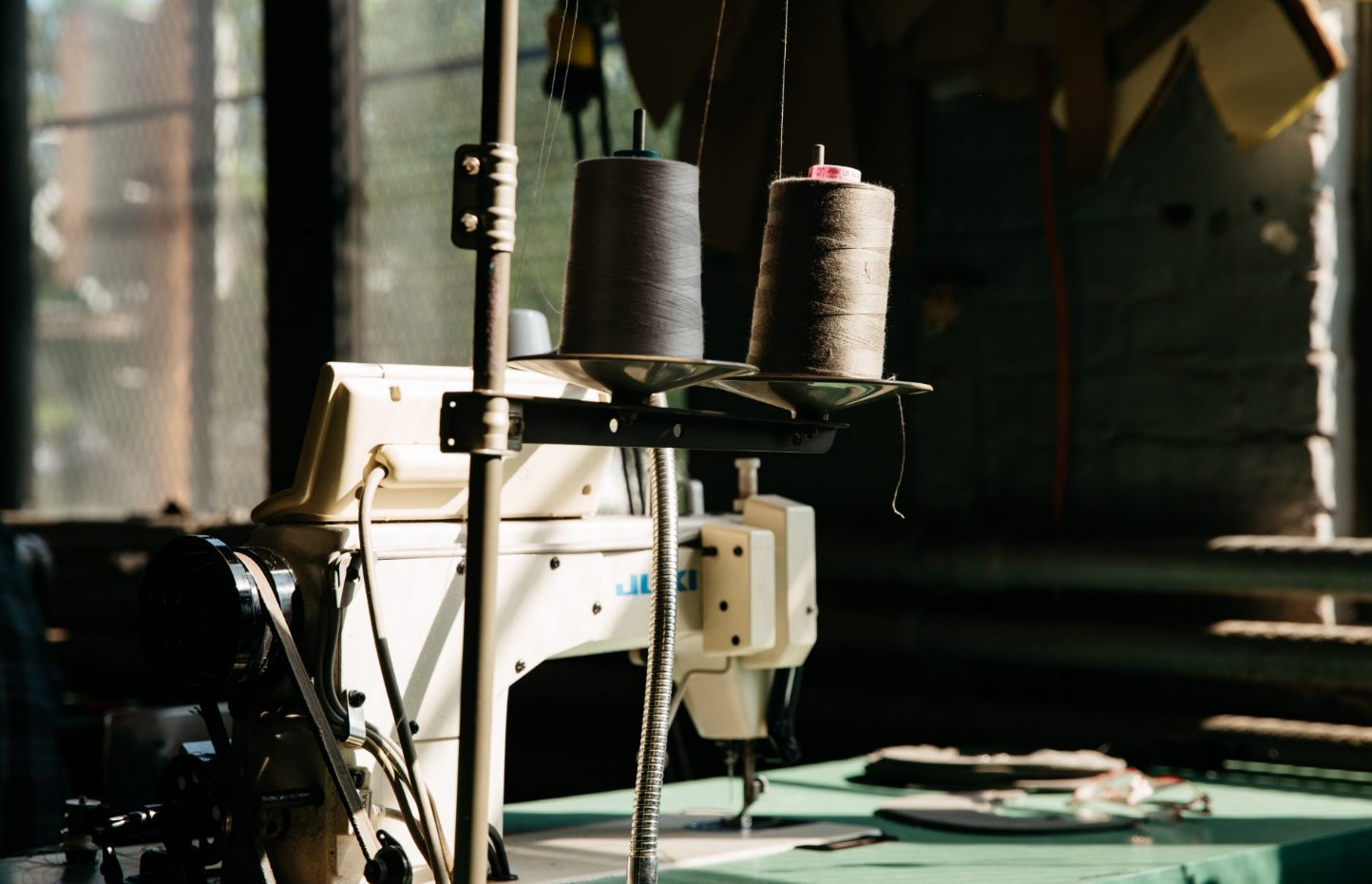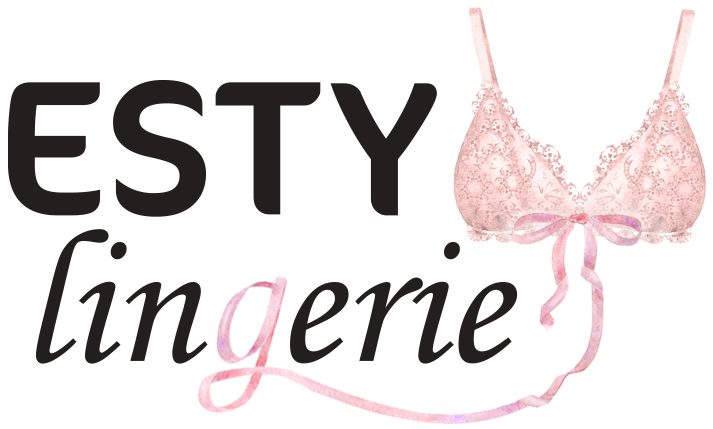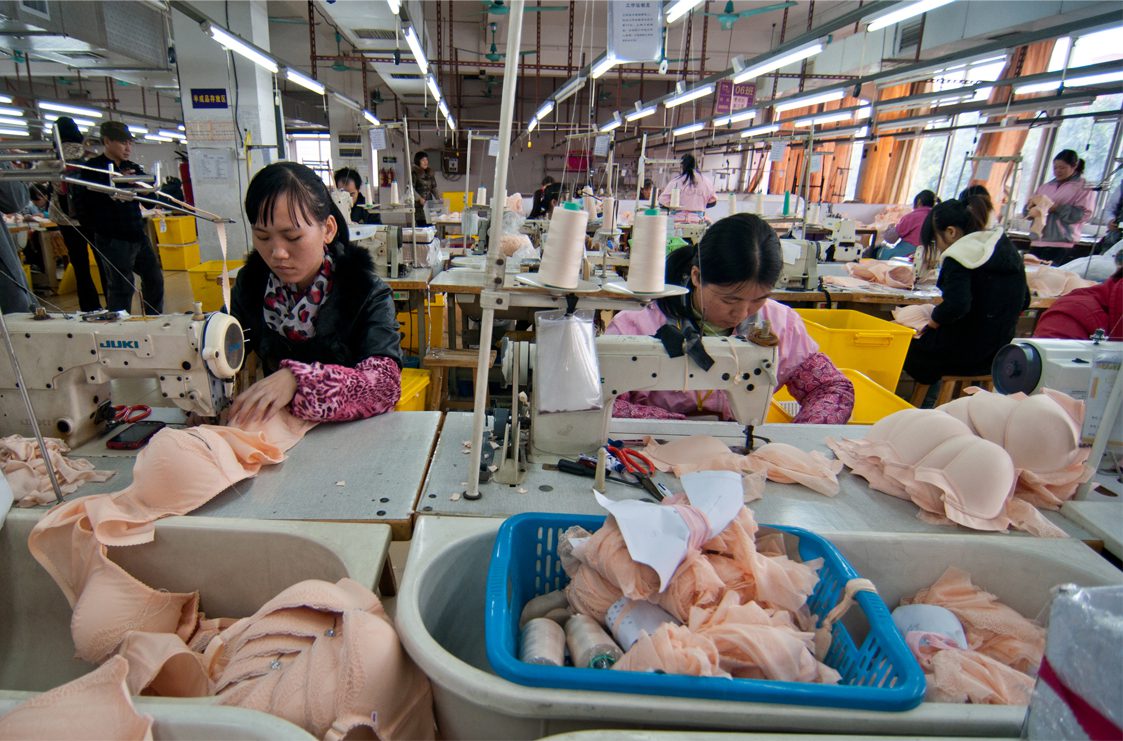Note: This article was updated on 4th November 2016.
Obviously, I love independent designer lingerie. I make it, I sell it, I blog about it and I most definitely buy it. However, when it comes to mass produced vs. indie lingerie, I don’t think you have to choose a side. Lingerie that’s made in China has a pretty bad rep but whilst some of it definitely deserves that, it doesn’t all. Here’s why I’m defending (some) Chinese-made lingerie…
Myth #1 – Lingerie that’s made in China is of poor quality
This is by far the biggest reason that many people avoid buying lingerie that’s been made in China. I’ve seen terrible-quality lingerie from China, but I’ve also seen poor-quality lingerie made right here in the UK.
Many luxury lingerie brands such as Mimi Holliday and Agent Provocateur outsource production to China, and I own many excellent-quality sets (here’s an example) that were made in China.
Lingerie production often requires expensive, specialised machinery – such as those that make molded cups – and that technology is hard to find in the UK or even the US. China on the other hand has plenty of factories with this equipment, and a workforce skilled in using it.

Myth #2 – Garment factory workers work almost for free
This is another big one, and even if the garments are gorgeous many people still prefer to shop elsewhere from a brand that pays its workers a fair wage. Now, I’m not defending Chinese wages here which are well known for being low, but they might not be as terrible as you think.
A significant number of lingerie factories (mainly those producing low-quality lingerie) are located in the Guangzhou disctrict where the minimum wage is 18.3 CNY per hour (approximately £2.17). Considering that the minimum wage in the UK is currently £7.20 per hour for workers aged 25 and over, at a first glance it’s hard to work out how someone could survive with Chinese earnings.
Wages, however, are only relevant to the cost of living, which is considerably lower in many parts of China than in the UK. In fact, China itself is aware of the relationship between wages and cost of living, which is why they have a different minimum wage in different regions. To put things into perspective, a one-bed apartment outside of the city centre in Guangzhou costs around £250 in rent each month according to this site, which is far below what you’d pay anywhere in the UK.
Also, let’s not assume that all Chinese lingerie factory workers are on the absolute minimum wage. Lingerie production is skilled work.
Myth #3 – The lingerie is all counterfeit goods
Yes, a lot of counterfeit goods come out of China, no doubt due to their lack of copyright laws. eBay and Amazon are full of Chinese copies of European or US lingerie brands, often sold using images of the original product when the actual item you’ll receive is a poor-quality copy.
However, not everything that comes out of China is a copy! If you buy from a well-known brand that’s made in China you can be sure you’re getting an original (and possibly even high-quality, depending on the brand) piece. If you’re buying on an auction site like eBay, be wary of too-good-to-be-true prices and avoid ‘unbranded’ items.

Aimer lingerie – one of the best-known Chinese lingerie brands.
Myth #4 – Lingerie made in China should be cheap
Some people don’t have a problem with a label that says ‘made in China’, but do have a problem with Chinese-made lingerie that isn’t extremely cheap. Thanks to all the Chinese lingerie being sold at very tiny prices, combined with the common knowledge that production costs are much lower in China than the UK, there seems to be a perception that anything made in China should be cheap.
Lingerie brands that outsource to China are saving money – otherwise they wouldn’t be doing it – but don’t forget that they then have to pay transport and customs fees. And, like any other brand, spend money on marketing and other overheads. Labour is only one portion of what it costs to produce and sell a garment. If it costs £5 to make, that doesn’t necessarily mean it can be sold for £10 and make a profit.
Believing made-in-China lingerie should be cheap is also assuming it’s low quality and as I’ve already explained, that’s simply not always true. My Mimi Holliday set that’s made in China is crafted from silk and a beautiful eyelash lace, certainly not low-cost fabrics!
Myth #5 – Handmade lingerie is better
Last but not least, is handmade lingerie really all that better than what’s made in a factory? This might sound weird coming from someone who sells handmade lingerie, but I use the terminology ‘handmade’ because it’s what customers know. They associate the word with ‘artisan’, but in the end all lingerie is handmade. Do Chinese factories employ robots, or press a button on a machine that starts pumping out lingerie? No. The lingerie is made by seamstresses – yes, with their hands.
The quality of any lingerie depends very much on four things – the fabrics, the design pattern, the quality of the equipment, and the skill of the person making it. As I mentioned at the beginning of this article, Chinese lingerie factories have both the right equipment and a workforce that’s experienced in using it. They’re well-equipped to make fabulous-quality lingerie if they want to!
So, those are my arguments. What do you think of made-in-China lingerie? I’d love to hear your opinions!



16 comments
Chinese made goods are most definitely of a lower quality, no matter what anyone claims. Those people that claim Chinese made goods are the same as the goods made in the UK, the USA, Canada or any other similar nation are liars. I would never buy anything made in China when an alternative made in another country is available.
I did feel that way for many years, and I have seen a LOT of low-quality lingerie made in China. However it’s definitely not all like that – my Lepel bra set is made in China and is one of the most well-made and perfectly-fitting bras I’ve ever bought! From my experience I’d say UK/USA/European lingerie is higher quality on average, but averages are just that – some factories will be much better, even in China.
Forget lingerie; At this point in time, it’s pretty difficult to avoid anything that is not made in China. In fact, I would have a hard time believing that the computer (or mobile device) you’re using right now does not contain parts that are made in China. With that aside, a few things to add to your article:
1. China is a HUGE country with MANY sub-cultures. Sure, Mao tried to push for a cultural revolution some 70 years ago, but the reality is, it’s a culture of over 3,000 years old with strong traditions in each area. Most factories today were created after 1989 (Tiananmen Square Massacre), and for the most part, these factories are located in the south (which is where my family and most early Chinese settlers are from). However, much of this has changed as factories are created in the north (ie: https://www.scmp.com/video/china/2144094/sex-sells-inside-rural-chinese-town-built-lingerie). As a result, consistency can be difficult to find – not all Chinese factories are created equal.
2. Size – As a woman who is 5’3” and more or less 125 pounds, I had to buy a XXXL for my wedding dress. I am not fishing for complement; my point is: people who live in China (and most of Asia) are petite. This is why Westerners may need to order sizes that are slightly bigger than they are used to. This is no different than when an American woman (which is what I am) orders from a UK brand. Most people can tell you that the UK size 8 is way smaller than an American size 8. You can live and learn or do your research.
3. No one is pointing a gun to your head to buy Chinese Lingerie. As you can tell by now, I am Chinese-American. Must I only purchase goods that are made in China? Absolutely not. Thanks to the internet, independent brands from all over the world are given an opportunity to sell and source.
Bottom line: Chinese factories will not have the same heritage, experience, and quality control as other nations. However, this is also a country that modernized extraordinary fast over the past 30 years. What we are exposed to today, may be a completely different story 50 years from now.
Hey, thanks for your thoughtful comment and for adding some new details (I didn’t know about most factories being built so relatively recently!) 🙂
I definitely agree on the size thing. I know I’ve heard people say that Chinese clothing is ‘terribly made’ because it’s ‘all so tiny’ (and that it’s made that way specifically to save on fabric costs), but you’re right, there are sizing inconsistencies between other countries too. It’s normal to wear different sizes across different brands, and *especially* when those brands are based in separate countries with different sizing standards.
Thank you, Estelle for this article! I couldn’t agree more.
I make my range Fr\E4ulein Annie in China at a factory that has a skill set that is out of this world! I work very closely with them for many years, we produce for most luxury European brands. My collection is made in very small runs and very exclusively according to my designs and patterns. It is not cheap. In fact, I reckon I could get it cheaper out of a European factory but not with this quality and attention to detail. I keep my prices a little lower than other brands of the same quality because I keep my own overheads low and don’t have any employees. So the savings are on my end, not at the factory.
The factory takes copyrights very seriously. They do not produce for brands that are in direct competition with each other. They do not copy other designs. Why would they need to? The designers of the European brands visit China regularly and work with the team there on development and fit. My factory even invented new technologies and garment constructions, they are very creative technically. I go to China several times a year for over 10 years now and always enjoy working there. Their attitude to work is fantastic, they are studious and take pride in what they do, they listen and want to learn and improve, even if they are experienced in their field. They are great team workers as well. They became a second family to me.
The Chinese government has become rather strict with work law and minimum wages in the course of the last years. My factory has always paid more than other factories because they want their workers to stay. Making bras is a skill that you need years to learn and perfect. They couldn’t afford to constantly have to train new staff because they go somewhere else where they are better paid.
China factories who produce for Western companies are also under close observation by international organisations like WRAP. These independent organisations visit the factories on a regular basis and look at working conditions, quality standards etc. It’s like a very strict MOT for factories.
I guess the people who think that product made in China must be low quality think about the days of mass production when you could buy a bra for less than what your lunch costs you? Times have changed. China is catapulting itself from 3rd to 1st world wealth and standards. The times of cheap mass production are over, at least for product made in China.
Thanks for your lovely comment Frauke 🙂 It’s good to see a brand thinking about more than just cost when choosing a factory!
I sell lingerie on ebay at the moment, its all manufactured in china I have 100% feedback on the lingerie with excellent comments from all customers on the sizing & quality. [link removed]
Dear Estelle,
thank you very much for the article.
We’re Taiwan Lingerie exportation company, and our factory is in China,I could really related to your words.
The quality of “Made in China” is actually & heavily depends on “who is the boss behind”. Nowadays almost every famous brand outsourcing the manufacture to China, yet they (as well as we XD) still able to present good stuff to the customer to maintain our reputation. How? by restrict QC standard.
and by every means the QC thing with China factory is dreadfully painful….(imagining babysit sloppy adults who talk back with incredible reason)
Yet, still, with Discipline QC, Good thing could come up from China,
and because of QC, it won’t be any cheap.
And sometime I really wish China workers could produce the items by some magical bottom (so the quality will be more consistent)
yet I must voucher your statement: they DO make it by HAND.
Hi,
Thanks for stopping by, it’s great to hear about this from the perspective of someone who actually owns a factory in China! I do agree that quality control standards play a big part in the quality of the final garment, and that will vary from factory to factory.
You make *some* valid points, BUT you are using a common play on words to portray an image of ‘handmade’ that isn’t strictly true in order to validate your opinion. When a typical person visualizes ‘handmade’ they see a person handstitching it, they do not visualize several people in a large Chinese garment factory in a production line (seriously, you are kidding yourself if you think only one person does every single task involved in making a bra) and using words play “yeah, with their hands” well, by your reasoning, The Gherkin is entirely handmade. Calling these workers seamstress’ is just a noun for “a woman who earns her living by sewing” Yes, Etsy ‘prides’ itself on handmade indie labels, but even you must be aware (saying as you admit you use cheap Chinese labour) the uproar caused by ETSY allowing ‘indie’ labels to use sweatshop labour, and calling it handmade is a smack in the face to those on here who stay true to the word. To try justifying such use by claiming it probably would be cheaper to have it produced in the UK/EU is another slap to every single jobless ‘seamstress’ you could have employed, and helped to boost local economy & jobs for in your view, not much profit. 👿
Hi,
Thanks for commenting. I didn’t say I use ‘cheap Chinese labour’ (my items are all hand sewn or machine sewn by myself) and I also didn’t say it’s cheaper to produce lingerie in the UK/EU. I actually said it was cheaper in China.
I’ve also explained in the article what ‘handmade’ means to me – independent designers – and this article isn’t supposed to be Chinese-manufactured vs. indie-made lingerie and which one is better. I LOVE indie lingerie and I do what I can to support indie designers (which I think is quite a lot, considering my website). I just also don’t have a problem with buying lingerie that has Made in China (or Pakistan, or India, or wherever) on the label and this article was my way of explaining why. China-made lingerie isn’t all ‘cheap tat’ like it’s often made out to be – some of it is, sure, but far from all of it.
I know I am late to this party, but we are impoverishing our own people in order to raise the standard of living in other countries. A Chinese garment worker can easily afford a 1-bedroom apt, while a college graduate can barely afford a 1-room studio in the USA or UK.
Also it is only a matter of time (and it has already started) that the Chinese will stop making for US and EU companies and do it all themselves, and then we wont even be the designers any more, have no way to manufacture for ourselves, and probably have to pay higher prices or whatever the Chinese want to ask, as they will control the entire supply chain.
We simply cannot be a culture that only buys, people have to earn a living wage somehow outside the service industry.
At the beginning of the 20th c. the largest occupation in Great Britain was domestic service and by destroying middle class jobs, we are moving back to that type of society.
Lol, your article’s arguments are so empty, honestly, this article is a shame. There’s absolutely no point in defending made in China products, which are part of a HUGE UNSUSTAINABLE BUSINESS MODEL, that affects people, the environment, etc., unless you’re Chinese.
Hi Anna, I’m not sure what you’re getting at exactly? That I should automatically dislike made-in-China lingerie because I’m not Chinese?
The point of this article is to break down some common myths/stereotypes about made-in-China lingerie. For example, that *everything* made there is part of that huge, unsustainable business model you are talking about. Which definitely exists, but there are luxury/handmade/sustainably-made/etc. lingerie brands in China too – https://www.love-pillowbook.com/ for example.
9 year old article but still valid, and even more so in my opinion. I think the quality is not about where it is made but the QC of the final product. It is so true people expect that chinese products should be cheap. But I am sick and tired of people complain about their low quality ‘made in china’ product after they have chose a low priced item on the market. From personal experience, ‘made in china’ is getting so much better these days, if I am willing to pay just 50% more than what is normally ‘expected’ for chinese products, I often find myself getting much more value than the extra cost. I always feel like saying, give the ‘not-so-cheap’ chinese products a try, and try them with an open mind. I am not pro certain countries here, I simply do not agree with biased views that are so often not justified. Thank you for this article, it is definitely a refreshing one.
Thanks for stopping by! Always nice to see a comment on an older article – I’m glad they’re still getting read 🙂